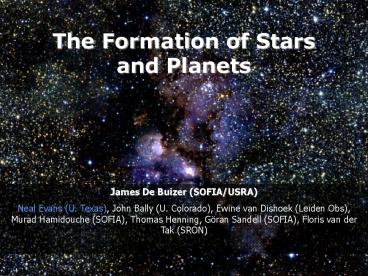The Formation of Stars - PowerPoint PPT Presentation
1 / 15
Title:
The Formation of Stars
Description:
The Formation of Stars. and Planets. James De Buizer (SOFIA/USRA) ... Three major themes were chosen within the general star and planet formation topic ... – PowerPoint PPT presentation
Number of Views:60
Avg rating:3.0/5.0
Title: The Formation of Stars
1
The Formation of Stars and Planets
James De Buizer (SOFIA/USRA) Neal Evans (U.
Texas), John Bally (U. Colorado), Ewine van
Dishoek (Leiden Obs), Murad Hamidouche (SOFIA),
Thomas Henning, Göran Sandell (SOFIA), Floris van
der Tak (SRON)
2
Three major themes were chosen within the general
star and planet formation topic
3
Three major themes were chosen within the general
star and planet formation topic
4
SOFIA will determine the chemistry of disks as a
function of radius
- The cartoon of a rotating disk above is
color-coded as a function of r - We have only a general idea of where species may
be located in disks
5
SOFIA will determine the chemistry of disks as a
function of radius
- High spectral resolution (R105) can determine
where species reside in the disk by
velocity-resolving their lines
6
SOFIA will determine the chemistry of disks as a
function of radius
- Material at small radii produce double-peaked,
wider lines. - With Keplers Law one can deduce the radius
- Spatially resolving the disk is not necessary
7
SOFIA will determine the chemistry of disks as a
function of radius
- Material at small radii produce double-peaked,
wider lines. - With Keplers Law one can deduce the radius
- Spatially resolving the disk is not necessary
8
SOFIA will study how the chemistry of disks
evolves with time
- SOFIA can be used to study lines of OI at
63mm, OH at 119mm, CII at 158mm and determine
where they form - By studying a variety of disks at different
ages, one can study chemical evolution - The H2O at 6mm (gas) can probe the inner disk
where there are migrating icy bodies and 45mm
can probe beyond the snow line where icy
bodies form
9
Three major themes were chosen within the general
star and planet formation topic
10
SOFIA will help disentangle the sources of
luminosity in massive star cores
IRDC G11.11-0.12 from Spitzer
4
- The fundamental property of a star is its
luminosity! - For many massive star cores being studied it is
unclear if the luminosities observed at short and
long wavelengths are coming from the same source
or multiple sources
11
20 to 100 mm provides a key link between shorter
and longer wavelengths of the SED
- Sources with short long wavelength emission
require more data with good spatial resolution
and spectral sampling from 20-100mm to determine
the sources of luminosity
12
Many sources have no (or poor) data at lunderstanding their true nature is extremely
difficult
- Observations are easy with SOFIA (sources are
bright in FIR) - Narrow filters will allow detailed sampling of
SED
13
Three major themes were chosen within the general
star and planet formation topic
14
SOFIA may resolve the puzzle of the missing
oxygen in cold clouds
- Understanding the oxygen cycle is a key
astrobiological concern - SOFIA is the only mission that can provide
spectrally resolved data on the OI lines at 63
and 145 mm - Gaseous atomic O is the likely reservoir for the
missing oxygen that can be probed by the above
lines, but velocity resolution is needed to
localize the emission - The other main reservoirs that can be probed are
OH (ground state line at 119mm) and H2O
15
SOFIAs Role in Star and Planet Formation Studies































